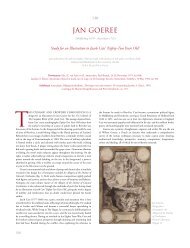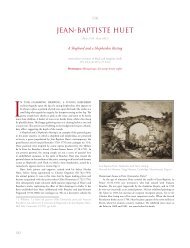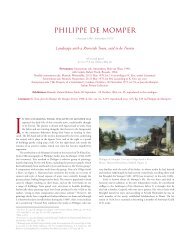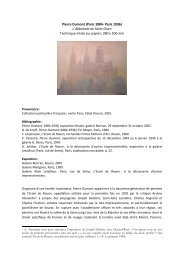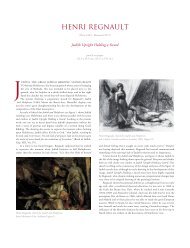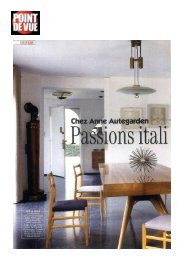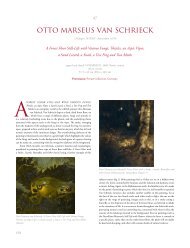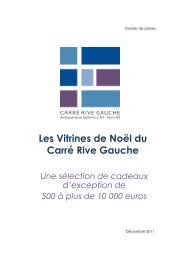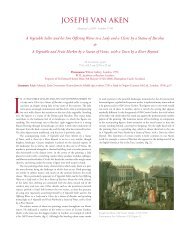La Nature Se Dévoliant Devant La Science
La Nature Se Dévoliant Devant La Science
La Nature Se Dévoliant Devant La Science
Create successful ePaper yourself
Turn your PDF publications into a flip-book with our unique Google optimized e-Paper software.
‘<strong>La</strong> <strong>Nature</strong> <strong>Se</strong> <strong>Dévoliant</strong> <strong>Devant</strong> <strong>La</strong> <strong>Science</strong>’<br />
A Fine Multipatinated Bronze Figure by Louis-Ernest Barrias<br />
Cast by Susse Freres. Paris, Circa 1900<br />
‘<strong>La</strong> <strong>Nature</strong> <strong>Se</strong> <strong>Dévoliant</strong> <strong>Devant</strong> <strong>La</strong> <strong>Science</strong>’ - nature revealing herself before <strong>Science</strong>; a very<br />
fine multipatinated bronze figure with varied gilt highlights and green tinted Scarab Beatle<br />
by Louis-Ernest Barrias (1874 – 1905), cast by Susses Freres.<br />
Signed: ‘E. Barrias’, inscribed: ‘Susse Fres Edts Paris’. Stamped: ‘P’ and with the ‘Susses<br />
Freres Editeurs Paris’ Cachet.<br />
This important bronze figure is a finely cast example of Barrias's most celebrated work, a<br />
homage to advances made in scientific exploration and a masterpiece of early Art Nouveau.<br />
The figure depicts a young woman, the allegory of <strong>Nature</strong>, removing her veil to reveal her<br />
face and bare breasts to the cold gaze of science.
Following in the spirit of pioneers<br />
of polychromy such as Charles-<br />
Henri-Joseph Cordier and Eugène<br />
Cornu this figure was carved using<br />
expensive and luxurious materials<br />
such as Algerian onyx for the<br />
drapery, lapis lazuli for the ribbon<br />
and malachite for the scarab. This<br />
figure is now in the collection of<br />
the Musée d’Orsay.<br />
The figure first appeared in white marble at the Paris<br />
Salon of 1893 with the longer title of '<strong>La</strong> <strong>Nature</strong><br />
mystérieuse et voilée se découvre devant la <strong>Science</strong>’ in<br />
its fully nude form. Suitably it was purchased by the<br />
medical faculty at l'Ecole de Médecine in Bordeaux.<br />
Barrias returned to the theme a few years later<br />
exhibiting a related sculpture at the 1899 Salon, simply<br />
titled ‘<strong>La</strong> <strong>Nature</strong> se dévoilant'.<br />
Above: ‘<strong>La</strong> <strong>Nature</strong> se dévoilant', exhibited in 1889<br />
Left: The 1902 Version in white marble<br />
Left jggggggggggggggggg<br />
A final version in white marble was made in 1902 and<br />
acquired by the École de Medicine in Paris.<br />
Left :
The first bronze casts were exhibited by Susse Frères, in various sizes and to great critical<br />
acclaim, at the 1900 Exposition Universelle. Awarded a prestigious Grand Prix at the Liège<br />
Exhibition of 1905, the renowned bronzier Théodore Millet deemed the bronze figure a ‘tour<br />
de force’ for the Susse firm and proclaimed it 'the finest of the works exhibited'.<br />
Louis-Ernest Barrias<br />
Louis-Ernest Barrias (1841 – 1905) was one of the most<br />
celebrated and influential sculptors of the late nineteenth<br />
century. Along with contemporaries such as Frédéric Auguste<br />
Bartholdi (of Statue of Liberty fame), Barrias was influential in<br />
re-inventing a new sophisticated approach to allegorical<br />
representation. This refined approach is evident in the<br />
romantic figure of<br />
<strong>Nature</strong> Revealing<br />
Herself, but also in the<br />
handling of themes of<br />
modernity such as his<br />
Allegory to Electricity for<br />
the Gallery of Machines at the 1889 Exposition<br />
Universelle.<br />
Born in Paris into a family of well known artists, Louis-<br />
Ernest started his career as a painter studying under<br />
Léon Cogniet. He later took up sculpture studying under<br />
Pierre-Jules Cavelier and following his admittance to the<br />
École des Beaux-Arts in 1858, François Jouffroy. In 1865<br />
Barrias won the Prix de Rome and was involved in the<br />
decoration of the Paris Opéra and the Hôtel de la Païva<br />
in the Champs-Élysées.<br />
Barrias in his studio<br />
Allegory to Electricity for the<br />
Gallery of Machines at the 1889<br />
Exposition Universelle<br />
In 1878 he was made a Knight<br />
of the Legion of Honour, an<br />
officer in 1881, and a<br />
commander in 1900. Barrias<br />
replaced Dumont at the<br />
Institut de France in 1884 and<br />
succeeded Cavelier as<br />
professor at the École des<br />
Beaux-Arts in the same year.
Susse Frères<br />
By the early 1830’s the firm was<br />
selling small bronze statuettes and<br />
began to focus seriously on the<br />
process of bronze casting as early<br />
as 1839. Under the direction of the<br />
brothers, Michel Victor and<br />
Amedee Susse, they produced in that year a six-page<br />
catalogue of bronze sculpture.<br />
Tracing its origins to 1758, the Paris foundry of Susse<br />
Frères is one of the oldest art foundries in Europe.<br />
Originally a stationery company they were<br />
appointed suppliers to Empress Marie Louise from<br />
1812 and the Duc de Berry from 1818. Following<br />
the 1830 revolution they were granted a Royal<br />
Warrant as an official supplier to the monarchy.<br />
Above& Above Left: Frontispieces from Susse<br />
Frères Catalogue of Bronzes<br />
In 1847 the firm obtained the right to use the Sauvage procedure for reduction, similar to<br />
the technique invented by Achille Collas and employed by Ferdinand Barbedienne. The<br />
ability to produce reductions of large scale bronzes enabled Susse Frères to create editions<br />
of work in various sizes and opened up the market to collectors and to commercial success.<br />
Michel Victor Susse died in 1860 leaving Amedee as the sole director of the foundry until<br />
1880, when Albert Susse became the director.<br />
Sauvage and his Reducteur Mechanique
Susse Frères obtained the rights to produce editions of the works of some of the most<br />
important French sculptors of the nineteenth century including: James Pradier, Pierre-Jules<br />
Mêne , Auguste Cain , Pierre-Nicolas Turgenev , Yevgeny Alexandrovich <strong>La</strong>nceray, Louis-<br />
Ernest Barrias , Jules Dalou , Alexandre Falguière and Mathurin Moreau.<br />
The list of Editions by Barrias in the Susse Frères 1905 Sales Catalogue
Renowned for the quality of its casting and<br />
rich multipatinated finishes, the firm exhibited<br />
with notable success at many of the great<br />
exhibitions of the nineteenth century,<br />
receiving a prize medal at the 1851 Great<br />
Exhibition in London and a Grand Prix at the<br />
1905 Lieges Exposition Universelle amongst<br />
other awards.<br />
Iconography and Allegory<br />
In this sculptural tour de force, Barrias draws upon allegorical and didactic themes from<br />
Renaissance and Baroque sculpture to create a figure that is visually striking - intimate and<br />
coquettish, yet provocative and revelatory.<br />
From ancient times allegory has been used<br />
to portray complex intellectual ideas and<br />
none has been more important in the<br />
history of art, than the concept of nature’s<br />
mystery. The iconography of Barrias’s<br />
figure plays into the historical trope of the<br />
Veil of Isis: the allegorical figure of the<br />
mythical veiled Egyptian goddess, who from<br />
ancient times represented the hidden<br />
mysteries of nature.<br />
The Susse stand at the Exposition Universelle of 1900<br />
Barrias’s Medals from The Great<br />
Exhibition, London 1851
The Scarab Beatle pinning the folds of<br />
the drapery, beneath the exposed<br />
bosom of the figure, acts as a signifier to<br />
the Egyptian origin of the representation<br />
and alludes perhaps to a more complex<br />
symbolism of death and resurrection<br />
and the contradictory character of<br />
nature itself. Perhaps it is a subtle<br />
warning that natures secrets maybe<br />
revealed, but at a cost.<br />
There have always been two<br />
contradictory approaches to<br />
Detail of the Scarab holding the drapery<br />
understanding nature and as Heraclitus<br />
pronounced Phusis kruptesthai philei –<br />
‘<strong>Nature</strong> loves to hide’. The philosopher Pierre Hadot in his book ‘The Veil of Isis: An Essay on<br />
the History of the Idea of <strong>Nature</strong>’, identifies the two approaches to nature as the<br />
Promethian, which through scientific<br />
investigation and discovery attempts<br />
to dominate nature and forcibly<br />
remove her veil, and the Orphic or<br />
poetic approach which seeks a unity<br />
with nature and views her<br />
divestment as a vulgar and<br />
uncivilised act.<br />
In Europe from the time of the<br />
Enlightenment scientific investigation<br />
played an increasingly important role<br />
in everyday life and Western<br />
consciousness. With the increasing<br />
pace of discovery, with mankind harnessing almost<br />
magical forces such as electricity and X-rays, it was<br />
Genius unveiling a bust of nature by Goethe<br />
with the bust of nature in the form of the<br />
veiled polymastic Isis<br />
only natural as the nineteenth century drew to a close, as Steven Armstrong writes, to<br />
conceive of this scientific progress as ‘Removing the Veil’.<br />
Barrias conceived this figural masterpiece therefore at a time when the two opposing ideas<br />
of nature were perhaps at their most divergent. Yet the genius of his sculptural approach<br />
and the relationship of his iconography to his artistic expression achieve something more<br />
tangible – a romantic vision of nature.<br />
As Hadot suggests there is an alternative approach to the unveiling of Isis (or nature), an<br />
expression non datur, one suggested by the Romantic vision of Rousseau, Goethe, and<br />
Schelling, an allegorical expression of the sublime - ‘<strong>Nature</strong> is art and art is nature’.
Literature:<br />
Hadot, Pierre, The Veil of Isis: an Essay on the History of the Idea of <strong>Nature</strong>, Harvard<br />
University Press.<br />
P.Fusco and H.W Janson, The Romantics to Rodin, Exhib, cat. Los Angeles Museum of Art,<br />
1980, pp. 118, 120, no. 10.<br />
Max Collignon, The Journal of ancient and modern art, 3rd year t. VI, No. 30, <strong>Se</strong>ptember 10,<br />
p. 191-198, Paris, 1899.<br />
Armstrong, Steven, The Veil of Isis: The Evolution of an Archetype Hidden in Plain Sight



